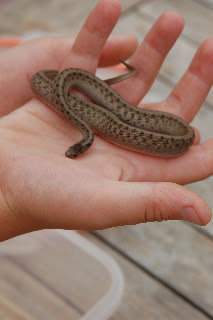This article covers the care of several native reptiles that often live in close proximity to people. As a result, they sometimes wind up in yards, basements, window wells and other such places. Most are also seen in pet stores. Often, folks are tempted to keep such reptiles as pets, especially when the “finder” is a child. The following information will give you an idea of what is involved in their care; please see the articles linked below for more detailed information, and post any questions you may have. If you find an injured animal, or wish to learn how to become a wildlife rehabilitator, please see this article.
 It is important to understand that captive-born specimens make far better pets than wild individuals, and that many species are protected by law, and we do not recommend taking wild animals from their native habitat and into your home. Snakes should never be approached unless you have the training and experience to distinguish venomous from harmless species.
It is important to understand that captive-born specimens make far better pets than wild individuals, and that many species are protected by law, and we do not recommend taking wild animals from their native habitat and into your home. Snakes should never be approached unless you have the training and experience to distinguish venomous from harmless species.
Painted Turtles, Chrysemys picta and relatives
Four very colorful species are found throughout the USA. Painted Turtles make wonderful pets that soon learn to “beg” for food when approached.
These active turtles may be housed in a 20 – 30 gallon or larger aquarium. They require deep water of 72-76F in temperature and a warm (85 F), dry basking spot; the Penn-Plax Turtle Pier is ideal. An incandescent bulb (for heat) and a reptile UVB bulb should be placed over the basking site. A strong filter and/or frequent water changes are essential.
Painted Turtles do well on a diet of ReptoMin Food Sticks, dried shrimp, earthworms, minnows, kale and other greens.
Garter and Brown (DeKay’s) Snakes, Thamnophis spp., Storeria dekayi
These common snakes have introduced generations of youngsters to reptile-keeping. The USA is home to 30+ species of Garter Snakes; they and the Brown Snake still occur in many large cities (I routinely find both in Manhattan).
Small in size and quite active, Garter and Brown Snakes are ideally suited to naturalistic terrariums stocked with live plants and a plastic cave. The screen top must be securely fastened with reptile cage clips. A water bowl and, for Brown Snakes, an area with moist sphagnum moss, should be provided. Room temperatures suffice, but one corner of the tank should be warmed to 82 F with an incandescent bulb. Low doses of UVB and UVA radiation, while not essential, may be beneficial.
Garter Snakes do well on a diet comprised of earthworms and minnows. Brown Snakes feed largely upon earthworms, but should also be offered slugs, beetle grubs and “smooth” caterpillars.
Snapping Turtle, Chelodina serpentina
Snapping Turtles rarely leave the water, but nesting females and newly-hatched youngsters are often encountered on land. Adults bite readily and with lightning speed, doing justice to the “serpentina” part of their name. They can inflict serious wounds, and should only be approached by experienced adults. The tiny hatchlings make charming, perpetually-hungry pets, but soon grow too large for most households.
Snapping Turtles require the same general care as Painted Turtles, but do not need a dry basking site or UVB radiation. Water should be of a depth that allows them to breath by stretching their necks to the surface while remaining submerged. Adults average 15-20 pounds in weight, but may get much larger…several males have tipped the scales at 70 – 80+ pounds!
Whole fishes, earthworms and Reptomin or turtle chow should comprise the bulk of their diet, but little in the way of meaty foods will be refused.
Watersnakes, Nerodia spp.
Approximately 15 species of these semi-aquatic snakes occur in the USA. Most average 2-3 feet in length, but several, such as the Florida Green Watersnake, may reach 5-6 feet. They are quick to defend themselves, but captive-born individuals sometimes accept handling. Where their ranges overlap, Watersnakes are easily confused with the venomous Water Moccasin…be sure you can tell the difference before approaching any snake.
Watersnakes can be kept, in general, as described for Garter Snakes. Newspapers, dead leaves or cage liners make good substrates; a water bowl large enough for soaking should be available. If not provided with a dry basking site, they quickly develop fungal skin diseases.
Their diet can be comprised of a variety of whole fresh-water fishes.
Box and Wood Turtles, Terrapene spp., Glyptemys insculpta
These mild-mannered, intelligent turtles are threatened throughout the USA, and should not be collected; individuals in need of assistance should be turned over to your state’s wildlife management. Captive born turtles make wonderful pets if given proper care.
Hatchlings can be reared in terrariums, but adults fare best in homemade cages or outdoor pens (please write in for details) equipped with a water bowl large enough for soaking. Average room temperatures are fine, but a warm (85 F) basking spot and UVB radiation must be provided.
A highly-varied diet containing earthworms, other invertebrates, Box Turtle pellets, ReptoMin Food Sticks, yams, carrots, apples, pears and other produce should be provided. Reptile calcium/vitamin supplements are essential.
Health Considerations
Salmonella bacteria, commonly present in reptile digestive tracts, can cause severe illnesses in people. Handling an animal will not cause an infection, as the bacteria must be ingested. Salmonella infections are easy to avoid via the use of proper hygiene. Please speak with your family doctor and see the article below for further details. Please also see the above cautions concerning venomous snakes and Snapping Turtles.
All wild-caught animals play host to a variety of internal and external parasites, and should be seen by an experienced veterinarian. Please [post below if you need help in locating a veterinarian.
Further Reading
Salmonella Prevention Guidelines
Please also see articles linked after each account above
 That Reptile Blog – Reptile, Amphibian and Exotic Pet Care and Information
That Reptile Blog – Reptile, Amphibian and Exotic Pet Care and Information





I loved catching garter snakes as a child 🙂 Many good memories. Since my parents wouldn’t buy me a reptile I could only keep whatever reptiles or bugs I found in our field.
Would love to see a post on keeping various lizards and amphibians that are found in the US. I used to catch leopard frogs quite often as well.
Hi paul,
Glad you enjoyed, thanks; below are links to some articles on native species. many more posted as well; some, i.e. garter snakes, have several parts…link to other parts should be in text. Any comments on your experiences, etc would be appreciated by myself and other readers, best regards, Frank
http://bit.ly/a5Lctf
http://bit.ly/117GTDz
http://bit.ly/9CG5mr
http://bit.ly/13w849F
http://bit.ly/133e8J2
http://bit.ly/mXvVaw